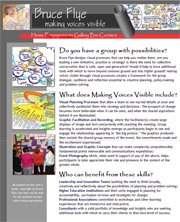 The opening session at the 2006 IAF Conference in
The opening session at the 2006 IAF Conference in I have always been circumspect if not cynical about the importance that so many organizations attach to leaders and leadership. Just a little reading about the likes of Horatio Nelson and Thomas Jefferson is convincing that even the “great ones” are at least as flawed as the rest of us, and we should be careful to use the broader society to assure that most of what emerges from leaders is good. The first book added some necessary layers to my simplistic view.
In Leadership Without Easy Answers, Ronald Heifetz describes leadership as “mobilizing people to tackle tough problems.” A distinction is made between “technical” and “adaptive” leadership, terms also used in the
Beginning with an assessment of “the gap,” a leader can take a path of shifting and/or sharing the work of major change to those being led, taking care to provide a productive environment and to match the rate of the presentation and discovery of issues to the capacity of the collective to deal with them. From a facilitator’s standpoint it makes for fascinating reading as it provides insights to a leader’s constraints and risks that actually come from both stakeholders and subordinates, as in the final analysis both are the sources of the leader’s authority.
Two of the case studies Heifetz uses are the Civil Rights movement and the Viet Nam War, issues – as well as leaders - seemingly far larger than most of us in this business will face. The relevance of the messages was improved, however, by the next book, Solving Tough Problems. Adam Kahane has not been involved in the Viet Nam War, but has instead dealt with national-scale issues in places like
Kahane describes his experiences and the lessons learned in how groups can come together to talk and listen meaningfully. The huge challenge and subsequent value of adaptive processes such as “generative dialogues” comes through in the quote from one participant: “We did not put our ideas together. We put our purposes together. And we agreed, and then we decided.” If there are doubts about the feasibilty of the approach described by Heifetz, Kahane begins to show what actually occurs among people that  makes transformations possible. Of particular note were the ways he describes “listening,” such that I’m now trying to relate that to occasions when I was using graphic recording as a tool for tuning in my own attentiveness.
makes transformations possible. Of particular note were the ways he describes “listening,” such that I’m now trying to relate that to occasions when I was using graphic recording as a tool for tuning in my own attentiveness.
The third book in the trio, Excellence Without a Soul by Harry R. Lewis, sharpened the messages of the other two by way of contrasts. I may try again later, but so far there has been little appeal in what comes across – to me at least – as a hatchet job on Harvard. (Oddly enough, Ronald Heifetz works at Harvard.) In all fairness, this is a book about the issue of purpose in great universities and not about planning or leadership per se. The book has value, however, at least as a reminder of the inability of much of the world to appreciate facilitative leadership.
“They discovered that a great curriculum does not crystallize out of scribbling by bureaucrats or squabbling among professors if the leaders cannot breathe into it direction and purpose.” Should we not think of a leader as someone who can mobilize the discovery of direction and purpose? Compare the quote, and its implied dependency upon leadership for purpose, to the experience described above, where a group put its purposes together. The need is argued for a leader whom “others will follow, not unquestioningly, but with confidence and respect.” Faculty, students and staff are then compared to “volunteers” who need motivating accordingly. It recalls Kahane’s broadened description of apartheid systems as well as Heifetz’s explanations of how adaptive challenges can be mistakenly treated as technical issues.
The need for enlightened and enabled leadership proclaimed in






